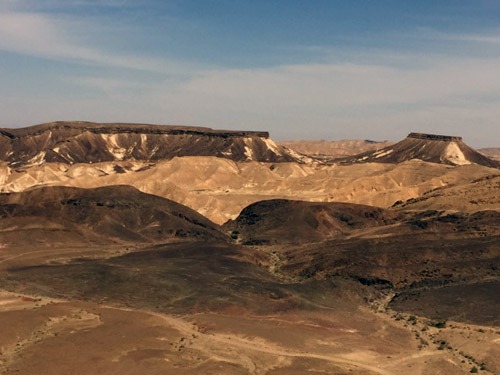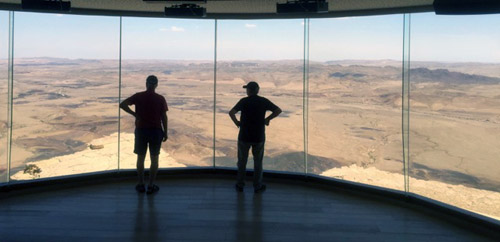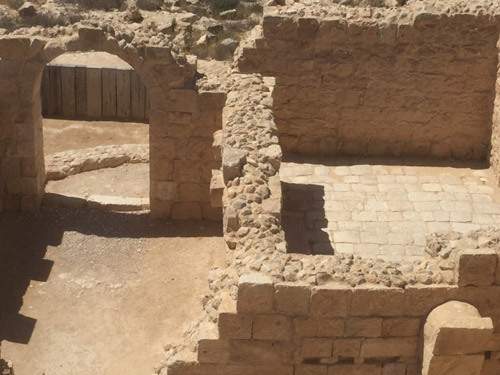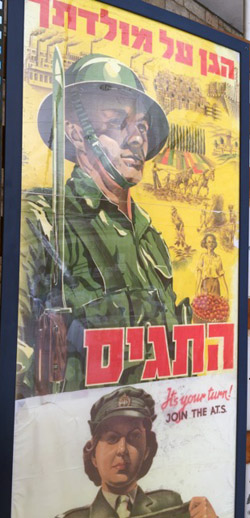
By Steve Kramer

ALFE MENASHE, IsraelPassover is probably the most celebrated holiday in Israel, with many families vacationing all over Israel. Less than a week later Israelis commemorate Yom Hashoah, the day to remember the victims and heroes of the Holocaust, many of whom live in Israel. A week later, we commemorate the victims of Israel’s wars and of terrorism, a sad day that segues into a day of celebration, Yom Ha’atzmaut, our Day of Independence.
The memorial days in Israel are workdays, although places of entertainment are closed. There is no commercialization such as the huge sales one finds on Memorial Day in the US. Yom Ha’atzmaut is different, a national holiday when most businesses are closed. But again it isn’t a day just for sales, but a day to visit museums, perhaps watch the Air Force flyover or go to the beach, and grill meat on the barbecue.
On the weekend after Yom Hashoah we visited the southern town of Mitzpe Ramon with a relatively large group of friends and our cousin Norman in tow. Mitzpe Ramon is situated at the edge of Makhtesh Ramon, the largest makhtesh in the world: 25 miles long by 5 miles wide, with a depth of 1,250 feet. Located in the Negev Desert, which comprises most of the lower portion of Israel, this huge crevasse reminds one of a miniature version of the Grand Canyon.
The Hebrew term “makhtesh” is a geological one which means “mortar” as in mortar and pestle. Because, except for only two other (small & un-named) makhteshim (pl) in Egypt, the makhtesh geological feature is unique to Israel. The word is sometimes mistranslated as “crater” due to their physical similarity, but there is an important difference. A makhtesh is caused only by erosion and has one or two interior “wadis” (dry river beds) leading to either the entrance or exit, and takes a hundred million years or more to form. By comparison, there is no crucial time factor in the creation of a crater, which can be caused by a meteor or may be just a hole in the ground. A canyon is a deep gorge, usually with a river entering and exiting through it.
We stayed overnight at a neat boutique hotel in Mitzpe Ramon’s “Spice Quarter.” which contains artsy/crafty stores, cafes, galleries, and our hotel, the Inn Sense. Its outstanding cuisine included unusual spices and combinations, exquisitely prepared, which really made dinner and breakfast delightful. We watched the sun go down over the desert from a large nearby hill, where we nearly got blown away by the strong winds. Spread before us was the magnificent Makhtesh Ramon.
We took a four-hour jeep tour of the makhtesh with our excellent guide, Nir, who explained quite a bit about the geography, geology, flora and fauna of makhteshim, which were rediscovered in modern times (1942) by Jewish explorers. In all, there are five of these unique geologic phenomena in Israel, with Makhtesh Ramon (perhaps derived from the Arabic word for Roman) being the largest.

After breakfast we visited the town’s tourist center which overlooks the crater. The futuristic structure attracts many visitors, some of whom are on the way to Eilat, Israel’s Red Sea resort several hours to the south. The newly redone (2013) Mitzpe Ramon Visitor Center offers interactive exhibits explaining the natural processes which led to the creation of the makhtesh and interesting information about the plant and animal life in what appears to be a barren and inhospitable region. The futuristic exhibit showing the development of Makhtesh Ramon over the eons was particularly fascinating. The center also serves as a museum and memorial for Ilan Ramon, Israel’s first astronaut who died in 2003, when the Shuttle Columbia disintegrated while re-entering the earth’s atmosphere. At the conclusion of the film on Ramon’s life, the curtains behind the screen parted to reveal a truly breathtaking and unexpected vista of the makhtesh.
After leaving Mitzpe Ramon, we stopped off the road at the ruins of the Nabatean city of Avdat. The Nabateans were Arab tribes who migrated to the area of southern Jordan and the Negev around 300 BCE, lived in that area for about 1,000 years, and prospered primarily from agriculture and commerce. The Nabateans were great practitioners of desert agriculture, using advanced irrigation techniques to grow olives, grapes, and other necessities.
“Simultaneously, they were maintaining commerce as an income, attending trading routes [such as the Spice Route] that stretched from the Arabian Peninsula to the Mediterranean Basin along which they were leading caravans loaded with medicinal herbs and incense. For supplying the needs of these commercial caravans, they had established a net of lodgings-guarded posts [caravansaries], which were placed in a distance of a one day walk from each other. In addition, the Nabateans built big cities.” Avdat was the most important city on the Spice route except for Petra, a UNESCO World Heritage site in Jordan, the Nabatean’s most magnificent monument. (www.tiuli.com)

The Nabateans, pagans who converted to Christianity in the 4th century CE, built large churches in their cities. Later, after the Arab invasion in the 7th century, many mosques were also built, often in place of the churches. In Avdat, we saw irrigation channels, a reservoir, and various remains of dwellings and storehouses and a Roman military camp. The Nabateans appear to have assimilated among the other peoples of the area after the 10th century CE, leaving their habitations intact for newcomers.
On Yom Ha’atzmaut, with friends Lawrence and Glenis, we drove up the coast to Netanya to watch the annual Air Force flyover. We went to one of Israel’s lovely cliffside beaches just north of town. Like on most of Israel’s beaches, there is a cafe with lots of outdoor, shaded seating. While we waited patiently in the gorgeous weather, we enjoyed a delicious lunch. By that time, the flyover had finished.

We then drove to the nearby Beit Hagdudim (Battalions Museum) at Moshav Avihayil, near Netanya. Both the moshav and the museum were established by veterans of the Jewish battalions of the British army. The museum depicts the struggle to create Jewish fighting forces (Zion Mule Corps and Jewish Legion in WWI; Jewish Brigade in WWII) and their contribution to building Jewish military forces to later fight for the establishment of the State of Israel. Among the most prominent of the Zionist visionaries for Jewish fighting forces were central figures in the history of the Jewish settlement: David Ben-Gurion, Joseph Trumpeldor, Ze’ev Jabotinsky, and others.
The British were correctly hesitant about training Jewish soldiers, especially ones from Palestine, because they knew that these trained soldiers would someday challenge the British forces in Palestine. In fact, the war veterans were the mainstay of the Haganah (defense) forces, which eventually became the core of the Israel Defense Forces (IDF).
On display in the museum are photographs, documents, flags, uniforms, posters, and such items as a life-size model of a mule and a soldier and other examples of the Jewish attributes of courage and volunteering. During the protracted war period, until 1945, Jews from the Yishuv (pre-state Israel) and the Diaspora joined the British Army to fight against the Nazis while gaining skills to fight for the Jewish State in Palestine.
We saw rare exhibits, short films and multimedia presenting the Hebrew battalions; accounts of the founding of the Zion Mule Corps and the Jewish Legion; tributes to volunteers to the Jewish Brigade; and examples of the Holocaust survivors and other volunteers’ contribution to the establishment of the IDF. There are also lawns and gardens for visitors’ enjoyment, a library and an archive. We were very impressed by this recently enlarged but still relatively small museum.
To finish off a wonderful day, we stopped in Netanya by the kikar, the picturesque pedestrian promenade and square next to the Mediterranean. We couldn’t resist the scrumptious pastry and coffee in the Sweet Dreams cafe, which we are sure is operated by some of the many immigrants to Israel from France, lately the country which supplies a plurality of Israel’s new citizens. It was a sweet ending to our vacation time in Israel.
*
Kramer is a freelance writer based in Alfe Menashe, Israel. He may be contacted via steve.kramer@sdjewishworld.com. Comments intended for publication in the space below MUST be accompanied by the letter writer’s first and last name and by his/ her city and state of residence (city and country for those outside the United States.)